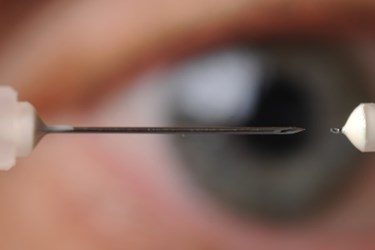Could Microneedles Replace Eye Drops For Ocular Diseases?
By Chuck Seegert, Ph.D.

Drug delivery through microneedles may replace eye drops for glaucoma and other eye diseases. Administered in an office setting, the needles can deliver drugs with a slow-release formula that could last up to 6 months.
Management of different forms of eye diseases often requires the daily application of medicated eye drops. Glaucoma is one such disease, and it affects many millions of Americans by causing elevated pressure in the eye. Another is called corneal neovascularization, which is the unwanted growth of blood vessels in the eye caused by reduced levels of oxygen. Corneal neovascularization is sometimes seen in people wearing contact lenses, and it can also lead to vision loss if left untreated.
Both diseases are exacerbated when medicines are delivered inconsistently, and patients sometimes forget to take their eye drops. The consequences can be severe and may include worsening vision or even blindness.
“The ultimate goal for us would be for glaucoma patients visiting the doctor to get an injection that would last for the next six months, until the next time the patient needed to see the doctor,” said Mark Prausnitz, a Regents’ professor in the School of Chemical and Biomolecular Engineering at the Georgia Institute of Technology, in a recent press release. “If we can do away with the need for patients to use eye drops, we could potentially have better control of intraocular pressure and better treatment of glaucoma.”
With this goal in mind, the Georgia Tech team developed an interesting approach using microneedle drug delivery devices, according to a recent study published in Investigative Ophthalmology & Visual Science. In the study, a hollow microneedle (33 gauge, 700 to 800 micrometers in length) was placed in the supraciliary space of rabbits. Drug release from the needle led to a significant decrease in intraocular pressure, the primary mechanism that drives glaucoma. This dose was delivered at the key location to have maximum effect and was able to perform its function, but at 100-fold reduction in drug dose compared to eye drops.
In related work, the team also used microneedles to treat corneal neovascularization in an animal, according to a separate study in Investigative Ophthalmology & Visual Science. Here they demonstrated that solid-core, drug-coated microneedles 400 microns in length mitigated corneal neovascularization. A single treatment of 4.4 micrograms of bevacizumab, a common treatment for corneal neovascularization, led to significant reduction in the disease. When compared to 52,500 micrograms of bevacizumab delivered by eye drops in the traditional manner, the single dose performed with a much greater effectiveness.
“The power of microneedles for treating eye conditions is the ability to target delivery of the drug within the eye,” said Prausnitz in the press release “We are developing different microneedle-based systems that can put the drug precisely into the part of the eye where it’s needed.”
While treatment of the glaucoma is an important part of the equation, providing real-time diagnostics and feedback to the patient is important as well. Recently in an article on Med Device Online, an implantable pressure sensor was discussed that delivered feedback using a smartphone app.
Image Credit: Georgia Tech Photo: Gary Meek
